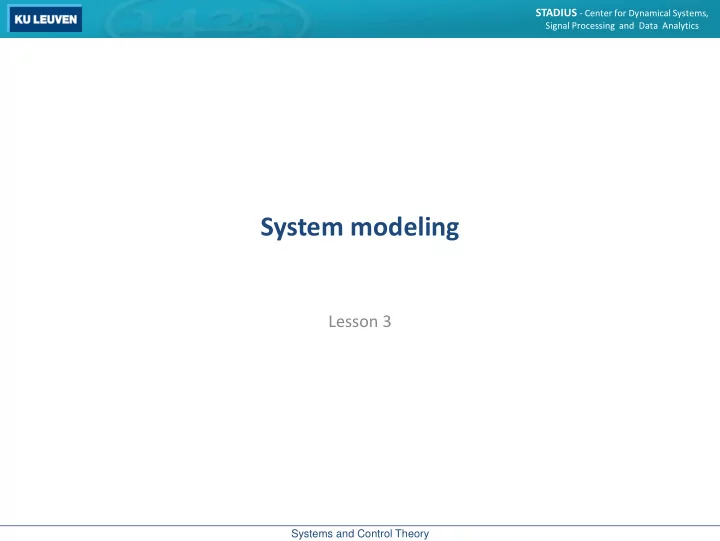

STADIUS - Center for Dynamical Systems, Signal Processing and Data Analytics System modeling Lesson 3 Systems and Control Theory
STADIUS - Center for Dynamical Systems, Signal Processing and Data Analytics Introduction Modeling of dynamical systems We can derive the mathematical model of a system in two ways mainly: Physical Modeling It consists of applying various laws of physics, chemistry, thermodynamics, etc., to derive ODE or PDE models. It is modeling from “First Principles” . Mass-spring system Inverted pendulum Tubular chemical reactor T T T J1 J2 J3 reactant reactant A A A B product C , T C T , in in B E C C RT v k Ce 0 t z E T T v G Ce RT H T ( T ) r r w t z 2 Systems and Control Theory 2
STADIUS - Center for Dynamical Systems, Signal Processing and Data Analytics Introduction System identification or Empirical Modeling It consists of developing models from observed or collected data. Dynamical system u t 1 ( ) y t 1 ( ) u t 2 ( ) y t 2 ( ) y ( ) t u t ( ) m n T T s s Identification Tuning parameters Algorithm For example: Mathematical Model y ( ) t f y ( t 1), ( y t 2), , ( ), ( u t u t 1), 3 Systems and Control Theory 3
STADIUS - Center for Dynamical Systems, Signal Processing and Data Analytics Physical modeling Systems and Control Theory
STADIUS - Center for Dynamical Systems, Signal Processing and Data Analytics Example: Mass Spring System Dynamical system Systems and Control Theory 5
STADIUS - Center for Dynamical Systems, Signal Processing and Data Analytics Mass Spring Damper System Systems and Control Theory 6
STADIUS - Center for Dynamical Systems, Signal Processing and Data Analytics Mass Spring Damper System https://www.youtube.com/watch?v=8DuJEpy-ODo Systems and Control Theory 7
STADIUS - Center for Dynamical Systems, Signal Processing and Data Analytics Example: Pendulum Systems and Control Theory 8
STADIUS - Center for Dynamical Systems, Signal Processing and Data Analytics Inverted pendulum Systems and Control Theory 9
STADIUS - Center for Dynamical Systems, Signal Processing and Data Analytics Flying Inverted Pendulum https://www.youtube.com/watch?v=15DIidigArA Systems and Control Theory 10
STADIUS - Center for Dynamical Systems, Signal Processing and Data Analytics Example: LC circuit Systems and Control Theory 11
STADIUS - Center for Dynamical Systems, Signal Processing and Data Analytics Example: RLC circuit Equations for each component Let V2 and i be the states. (They are already in the derivative). Model output as function of states and inputs Systems and Control Theory 12
STADIUS - Center for Dynamical Systems, Signal Processing and Data Analytics Example: linear circuit Equations from previous slide Writing the equations as matrices results in state space representation Systems and Control Theory 13
STADIUS - Center for Dynamical Systems, Signal Processing and Data Analytics Force-Voltage Analogy Systems and Control Theory 14
STADIUS - Center for Dynamical Systems, Signal Processing and Data Analytics Force-Voltage Analogy Force F Voltage e Mass m Inductance L Viscous-friction coefficient b Resistance R Spring constant k Reciprocal of capacitance 1/C Displacement Charge q Velocity Current i Systems and Control Theory 15
STADIUS - Center for Dynamical Systems, Signal Processing and Data Analytics Example: Hoover dam :inflow of water in :current volume of water in :outflow to river in :the current water level (height) in Systems and Control Theory 16
STADIUS - Center for Dynamical Systems, Signal Processing and Data Analytics Example: Hoover dam What happens when we open the gate? Outflow (like a brick of milk) We assume (falsely) that depends linearly on . Systems and Control Theory 17
Recommend
More recommend